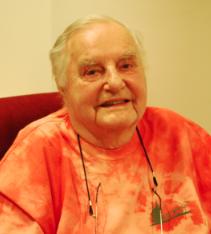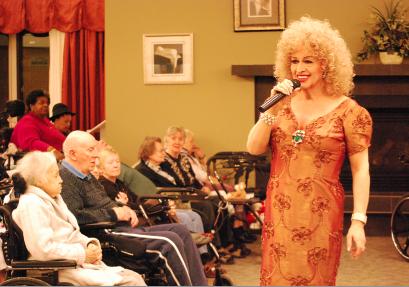
Ken Miller, a long-time openly gay resident at True Davidson Acres. Credit: Andrea Houston
Toronto drag queen Michelle DuBarry winks at members of the audience as she sways to classics from Nina Simone, Liza Minnelli and Judy Garland.
The 80-year-old local legend is not on stage at a Church St bar; she is entertaining at True Davidson Acres, the Toronto long-term care home where she performs a toe-tapping retro set once a month. Most of those watching are around the same age as DuBarry.
A few get up to dance.
“I tell them to save me a suite on the top floor of this place for the day I call it a day – complete with a few leather daddies to serve me,” DuBarry purrs as she flicks her hair away from her face.
True Davidson Acres is a city-run facility on Dawes Rd that is proudly “LGBT-friendly.” Staff have worked hard to create an accepting and welcoming facility, says counsellor Bernard Rughubeer, who points out the rainbow flag at the front entrance. He says long-term care must change with a changing community.
“Things began to really change five or six years ago; the work started earlier,” he says. “Staff went through training and education. The first step is acceptance of everyone, regardless of gender and sexuality. LGBT people have different needs.”
Ken Miller, 71, who has been a resident at True Davidson Acres for about 10 years, says he is very open about being gay. “I’ve never felt persecuted here . . . We celebrate Pride every year. People get dressed up and there’s usually a dance. Everyone here is open.”
There are more than 600 long-term care facilities in Ontario, Rughubeer says. “Most are not LGBT-friendly. There is a real push to change city homes.”
But change is happening at a much slower pace outside Toronto, says Camille Orridge, CEO of the Toronto Central Local Health Integration Network.
Orridge, who spoke last year at the 50+ LGBTQ Empowerment Conference at the 519 Church St Community Centre, says many horror stories about long-term care facilities are true. “There absolutely is homophobia and transphobia.”
That is especially true for seniors living outside Toronto. The 2011 documentary Gen Silent profiles gay, lesbian, bisexual or transgender older people who go back into the closet out of fear of discrimination by caregivers or bullying by other seniors.
“Long-term care facilities reflect society as a whole,” Orridge says. “That’s no excuse and I’m not defending it. When we age we lose some of our filters, so people are often more exposed.”
One of the main problems that contributes to the lack of understanding is that sexuality is not celebrated as people age, she says. “A lot of work is being done, but is it enough? I don’t know.”
“We need to expect a level of anti-discrimination, competence and training from providers. Even though we’ve had legislation against homophobia, it’s still alive and well.”
Orridge says it’s tempting to suggest that a facility geared specifically to the LGBT community should be created. But this is not the answer, she says. It ghettoizes people. Instead, she says, long-term care should work to make life better for gay seniors in every facility.
“We have seen long-term care facilities [geared to specific communities] emerge, such as a Chinese facility, an Italian home,” she says. “Where would you build such a home? The Village, presumably.”
But Orridge is quick to point out not every gay person in Canada lives near the Church and Wellesley Village. “There’s tons of gay folks that don’t live in the Village and have never lived in the Village. Now, when you get older you have to move there? That takes people away from their community.”
A better approach, Orridge says, is to offer ongoing training and education to staff and other residents in all facilities, and whenever possible, encourage providers to open specialized units within the home, much like what Fudger House on Sherbourne St has done.
Still, even in Toronto’s most gay-friendly homes gaps remain, especially for the queer community’s most marginalized members – trans people, sex workers, people of colour and people with HIV/AIDS. The most urgent gap, and one that continues to widen, is understanding how trans people are treated, Orridge says. “Given that homophobia is what it is, I suspect trans people are even more at risk.”
See the trailer for Gen Silent.

 Why you can trust Xtra
Why you can trust Xtra


